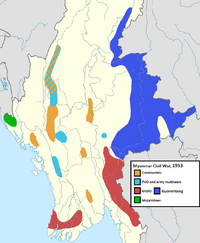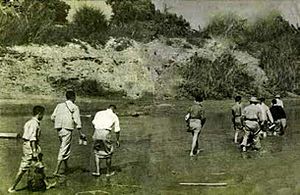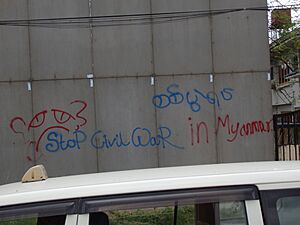Myanmar conflict facts for kids
Quick facts for kids Myanmar conflict |
|||||||
|---|---|---|---|---|---|---|---|
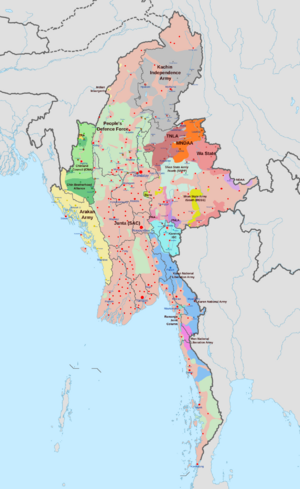 Military situation in Myanmar as of 4 February 2025[update]. Areas controlled by the Tatmadaw are highlighted in red. For a live map, see here. |
|||||||
|
|||||||
| Combatants | |||||||
|
Ethnic armed organisations |
||||||
| Commanders and leaders | |||||||
| Min Aung Hlaing | Duwa Lashi La | ||||||
| Units involved | |||||||
| Various (full list) | |||||||
| Strength | |||||||
| 150,000 (2023 USIP estimate) | Total number of fighters unknown | ||||||
| Casualties and losses | |||||||
| 180,000+ killed 600,000–1,000,000 internally displaced |
|||||||
Myanmar, also known as Burma, has been in a state of armed conflict since 1948. This was the year the country gained its independence from the United Kingdom. This long-lasting conflict is often called the world's longest ongoing civil war. It has continued for almost eight decades.
The conflict is mainly about different ethnic groups and their desire for self-determination. Many ethnic armed groups are fighting against Myanmar's official military, called the Tatmadaw. Even though there have been many peace talks and special self-administered zones created in 2008, these groups still want more independence or a federal system for Myanmar.
In 1940, during World War II, a group of Burmese thinkers formed the Thirty Comrades. They later created the Burma Independence Army (BIA) to fight against the Allies. Aung San led the State of Burma and later switched sides to support the Allies in 1944. After the war, Burma became independent in 1948. However, a promise of freedom for ethnic minorities, called the Panglong Agreement, was not kept after Aung San was killed. This led to new groups like the Communist Party of Burma and the Karen National Union (KNU) becoming stronger.
In 1962, General Ne Win took control in a coup. He refused to create a federal system, which made more groups start fighting. The Communist Party of Burma and ethnic groups like the Kachin Independence Army and Karen National Liberation Army began to fight the government. Ne Win's rule faced many challenges, leading to the 8888 Uprising in 1988. This uprising was stopped by the military.
After the uprising, the military formed a new government called the State Law and Order Restoration Council (SLORC), later known as the State Peace and Development Council (SPDC). This government also faced fighting, including the rise of the Arakan Rohingya Salvation Army (ARSA) in the 2010s. The conflict became much worse after the 2021 military coup. General Min Aung Hlaing led this coup, removing the elected government. This caused many protests and new fighting, especially in areas with ethnic minorities like Kachin State, Kayah State, and Kayin State.
How the Conflict Started
Early Steps Towards Independence
In 1940, during World War II, some young Burmese thinkers went to Japan for military training. They wanted to fight against British rule. This group became known as the Thirty Comrades. When they returned to Burma in 1941, they formed the Burma Independence Army (BIA). They fought against the Allies.
In 1942, the Japanese took control of Rangoon and set up a new government called the State of Burma. The BIA became its army. Aung San, a leader of the Thirty Comrades, led the State of Burma. He started to doubt Japan would win the war. In 1944, he decided to switch sides and join the Allies. Japanese forces gave up in July 1945. The British then began talking with Aung San and other Burmese leaders about Burma's independence.
Promises Not Kept
Before Burma became independent, Aung San talked with leaders from the Chin, Kachin, and Shan groups. They made an agreement called the Panglong Agreement. This agreement promised these ethnic minorities full freedom in their areas. It also gave them the choice to leave Burma ten years after independence.
However, Aung San was killed soon after. The government that took over did not keep the promises of the Panglong Agreement. This made relations worse between the Bamar majority and the many ethnic minorities in the country.
The Conflict's History
Fighting After Independence (1948–1962)
Burma gained independence from the United Kingdom on January 4, 1948. After this, the two main groups opposing the government were the communists, led by the Communist Party of Burma (CPB), and the Karen nationalists, led by the Karen National Union (KNU).
At first, things were calm. But on April 2, 1948, the CPB started the first fighting in Paukkongyi. In 1949, the CPB had about 15,000 fighters.
During this time, the KNU wanted an independent state for the Karen people. This state would have included areas like present-day Kayin State and Kayah State. The KNU has since changed its goal. Now, they want regional autonomy within a federal system, with fair representation in the government.
Ne Win's Military Rule (1962–1988)
After three elected governments, the Tatmadaw, led by General Ne Win, took control on March 2, 1962. They removed the elected government and set up a military junta. Many political leaders were arrested without trial. Around this time, other ethnic minority groups formed larger rebel groups, like the Kachin Independence Army. They did this because the new government refused to adopt a federal system.
Many rebel groups, both communist and ethnic, became interested in the idea of a "people's war" after peace talks with Ne Win's government failed in 1963. The CPB had close ties with the Chinese Communist Party (CCP). The CPB tried to copy China's Cultural Revolution. Many Burmese people saw this as China trying to interfere in their country. This led to violent 1967 anti-Chinese riots in Burma.
Ne Win held peace talks with rebel groups in 1962 and again in 1972, but both times they failed. One reason was Ne Win's refusal to have a federal multi-party system. After talks failed, defectors from the Tatmadaw and ethnic rebels went back to their bases. Newspapers famously reported, "They have gone back." The government took over private property. The Burmese Socialist Programme Party (BSPP) was formed in 1974 to rule the country as a one-party system.
Under Ne Win's 26-year rule, Myanmar became very isolated. It was one of the least developed countries in the world. In 1988, nationwide student protests led to Ne Win and the BSPP being removed from power. A new military government, the State Peace and Development Council, took over.
The 8888 Uprising
On March 12, 1988, students in Rangoon (now Yangon) began protesting against Ne Win's rule. The protests quickly spread across the country. The BSPP government was pressured to allow a multi-party system. However, the BSPP government was overthrown by a military coup on September 18, 1988. The military then formed the State Law and Order Restoration Council (SLORC). They used force to stop the protests by September 21, 1988.
Myanmar authorities said about 350 people were killed. However, opposition groups claimed thousands died during the protests.
Aung San Suu Kyi became a symbol of Myanmar's movement for democracy during the 8888 Uprising. She led the country's largest opposition party, the National League for Democracy (NLD). The military government held a general election in 1990. The NLD won most of the seats. But the military government was surprised by this and refused to accept the results. They placed Aung San Suu Kyi under house arrest.
Military Rule Continues (1988–2011)
After ignoring the 1990 election results, the military government strengthened its control over Myanmar. The SLORC was replaced by the State Peace and Development Council (SPDC) in 1997. This council was made up of eleven senior military officers.
In the 1990s, the Tatmadaw greatly weakened ethnic rebel groups. They destroyed most of their bases.
In 2006, the Tatmadaw launched a large attack against the Karen National Liberation Army (KNLA), the armed part of the KNU. This fighting forced hundreds of thousands of civilians to leave their homes in Kayin State. It is estimated that about half a million people were displaced due to fighting and forced relocation by the government.
In 2007, hundreds of thousands of monks protested against the military government. They called for free elections, minority rights, and the release of political prisoners. This event is known as the Saffron Revolution. The protest started because the government removed price support for natural gas.
The Tatmadaw attacked Kokang in 2009. This caused the Myanmar National Democratic Alliance Army to lose control of the area. About 30,000 refugees had to flee to China.
In 2010, Tatmadaw forces had violent clashes with DKBA-5. This led to nearly 10,000 refugees fleeing to Thailand to escape the conflict.
Civilian Government (2011–2021)
The government introduced a new constitution in 2008. From 2011 to 2015, they started a period of political reforms. Thousands of political prisoners were released, including Aung San Suu Kyi. The 2008 constitution created special self-administered zones for six ethnic minority groups. In November 2014, the NLD tried to change the constitution. They wanted to remove a rule that stopped Aung San Suu Kyi from becoming President of Myanmar. However, these changes were not accepted.
In 2013, large anti-Muslim riots happened in several cities. This violence happened at the same time as the rise of the Buddhist nationalist 969 Movement.
In early 2015, the government invited 15 rebel groups to discuss a "Nationwide Ceasefire Agreement". A draft was agreed upon by most groups on March 31, 2015. The agreement was signed by President Thein Sein and leaders of eight rebel groups on October 15, 2015.
In Shan State, the military continued to fight the MNDAA during the 2015 Kokang offensive.

After the political reforms ended in 2015, the government held several peace conferences. One was the Union Peace Conference – 21st Century Panglong. The first meeting was in 2016, with more in 2017, 2018, and 2020. Some groups criticized the conference. They said it did not address their main ideas. They also said it left out the largest rebel groups that were still fighting. Critics also argued that Myanmar's constitution gave too much power to the military. They felt this stopped the country from achieving real peace and democracy.
On October 9, 2016, the Arakan Rohingya Salvation Army (ARSA) attacked Burmese border posts. This led the Tatmadaw to start large "clearance operations" in northern Rakhine State. These operations became more intense after a second large attack by ARSA on August 25, 2017. The violence that followed caused international concern. The United Nations High Commissioner for Human Rights called it an ethnic cleansing.
In late November 2016, the Northern Alliance attacked towns and border posts in northern Shan State. This alliance includes four rebel groups: the Arakan Army (AA), the Kachin Independence Army (KIA), the Myanmar National Democratic Alliance Army (MNDAA), and the Ta'ang National Liberation Army (TNLA). The rebels took control of Mong Ko on November 25, 2016. They left the town on December 4, 2016, to avoid harm to civilians from airstrikes by the Myanmar Air Force.
On August 15, 2019, Northern Alliance rebels attacked a military college. More fighting happened in the following days. Myanmar's military warned of a "full-scale war" if the Northern Alliance did not stop their attacks.
Military Takes Control Again (2021–Present)

On February 1, 2021, the civilian government led by the NLD was overthrown in a military coup. The Tatmadaw's commander-in-chief, Senior General Min Aung Hlaing, became the head of state. Aung San Suu Kyi and other senior government members were arrested. Large protests followed. People demanded that Min Aung Hlaing and the new State Administration Council (SAC) step down. They also wanted those arrested to be freed and the civilian government restored.
Anti-coup protesters used slingshots, molotov cocktails, and homemade shields. In March 2021, it was reported that many protesters went to border areas. They trained with rebel groups. This increased the risk of a countrywide civil war. The civilian government-in-exile, the Committee Representing the Pyidaungsu Hluttaw (CRPH), suggested forming a "federal armed force" to fight the military.
One of the first armed resistances by protesters happened in Kalay, Sagaing Region. After the Tatmadaw raided a protest camp there on March 28, 2021, protesters fought back with hunting rifles and homemade guns. Several rebel groups, like the Kachin Independence Army and the Karen National Liberation Army, also increased their attacks against the Tatmadaw after the coup.
Seven groups that signed the Nationwide Ceasefire Agreement joined the National Unity Government on April 4, 2021. These included the All Burma Student Democratic Front and the Karen National Union. Some of these groups have restarted fighting against the military government.
The Chinland Defence Force began its armed resistance in Mindat and Hakha, Chin State, on April 26, 2021.
On May 5, 2021, the National Unity Government announced its armed group, the People's Defence Force (PDF). This group was formed to protect supporters from military attacks. It is also a step towards a Federal Union Army. The PDF fought the Tatmadaw in Muse on May 23. Members of the Karenni People's Defence Force (KPDF) in Kayah State also fought the Tatmadaw near Loikaw.
The Communist Party of Burma rearmed itself. It announced its new armed group, the People's Liberation Army, in late 2021.
ACLED estimated that 11,000 people were killed from February to December 2021.
On February 10, 2024, the SAC started using a law from the SPDC era called the People's Military Service Law. This was done to get more soldiers through conscription.
Peace Talks and Agreements
Many rebel groups have tried to make peace agreements with different governments over the years. However, most of these agreements have not lasted.
After new constitutional changes in 2011, ceasefire agreements were made with several rebel groups. Fourteen of the 17 largest rebel groups signed a ceasefire with the new government. All 14 groups wanted talks based on the Panglong Agreement of 1947. This agreement promised self-determination, a federal government system (meaning regional freedom), religious freedom, and rights for ethnic minorities.
However, the new constitution only had a few rules about minority rights. So, the government discussed with rebel groups using the new constitution, not the Panglong Agreement. There was no single plan or group that included all the different factions. Because of this, the KNU left the conference. They complained about the lack of independence for each group within the ethnic bloc. Still, most of the talks between the State Peace Deal Commission and rebel groups were formal and peaceful.
On March 31, 2015, a draft of the Nationwide Ceasefire Agreement (NCA) was finished. It was agreed upon by representatives from eight rebel groups and the government. However, only eight of the 15 rebel groups signed the final agreement on October 15, 2015. Observers from the United Nations, the United Kingdom, Norway, Japan, and the United States witnessed the signing. Two more rebel groups joined the agreement later, on February 13, 2018.
The Union Peace Conference – 21st Century Panglong was held from August 31 to September 4, 2016. Many different groups were there to try and find a solution between the government and rebel groups. The talks ended without any agreement. The conference name referred to the original Panglong Conference held in 1947 during British rule. That earlier conference was negotiated by Aung San and ethnic leaders.
Impact on People
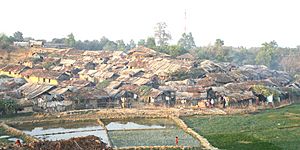
It is estimated that 130,000 people died in the conflict from 1948 to 2011. The Armed Conflict Location and Event Data Project (ACLED) has recorded over 53,000 deaths since 2011.
The conflict has also forced many civilians to leave their homes. Many have fled to nearby countries like Thailand, China, India, and Bangladesh.
See also
 In Spanish: Conflicto interno de Birmania para niños
In Spanish: Conflicto interno de Birmania para niños
- History of Myanmar
- Human rights in Myanmar
- List of ethnic groups in Myanmar
- Persecution of Muslims in Myanmar
- Politics of Myanmar
- Religion in Myanmar



